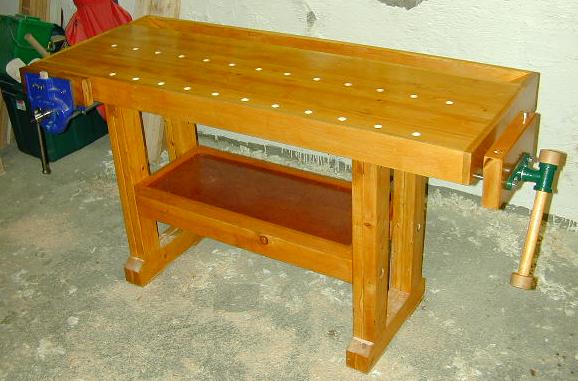

| Joint 2x4s before glue-up to reduce gaps in the top. Gaps can be
filled with a wood filler (I used Elmer's), it blends in well and took
shellac. Leave ends long and cut after slab is constructed. I didn't do this and had to resort to a belt sander to flatten off the ends which was murder on my back. After flattening, the top slab will finish out to approx. 3-1/8" thick (from the original 3-1/2"). The thin bit of wood left above the front vise's fixed jaw became too thin and I had to cut it out entirely and patch with a piece of maple. Once slab is glued up & flattened, make sides square & plumb especially where the apron will act as a vise face. Do this before measuring and cutting for the vise/s. Triple check the vise mounts. It's easier to chisel out pine/fir than the hard maple apron. Pre-tap vise mounting screw holes when the slab is upside down. Use liquid soap or bee's wax on threads. The loose pins in the feet make moving the bench a little difficult. Can't lift too high or they'll fall out, you gotta drag the bench. No biggie. Do not make the tool tray out of 1/2" ply--it's not strong enough. A 3/4" apron feels a little thin. Since the bottom edge of the apron hangs below the surface of the 2x4 slab, doubling up the material would yield a nicer 1-1/2" edge. I did glue strips of maple behind the bottom edges of the front apron and tool tray back to provide extra clamping surface. The tool tray was initially designed to be removable in case I didn't want it or to prevent damage in the event the bench is broken-down and loaded into a moving van. Pretty sure I'll keep it now and it could be braced for a move. In retrospect, it would look nicer to have cut the two side aprons long enough to comprise the ends of the tool tray instead of having a break between end of the slab and the plywood tool tray. But the tool tray is deeper than the apron so that would be another cut. I chose to make the apron 3-1/2" (vertical) based on how it landed on the front vise. Now, it's short of the screw and guide rods by 1/2". A uniform width apron across the sides would be as deep as the tray and since it would land in the middle of the vise screw, would have to be extended another inch or so just to not look stupid. At that point there is a fair amount of unsupported apron below the bottom of the slab. Probably okay if the apron were 1-1/2" thick, and/or the slab was made of 2x6s. Tool tray was made deep enough to bury a block plane. I'd like it to be a little wider so my big hands can grab something w/o barking my knuckles. Before drilling the dog holes, use pennies to get a feel for the spacing. This actually took longer than expected to work around the legs. I knew I wanted a hole to line up with the dog in the front vise and worked my way over to the end vise. 4-1/8" o.c. is what worked out. The caps on the handle of the end vise are from a thrift-store rolling pin. |